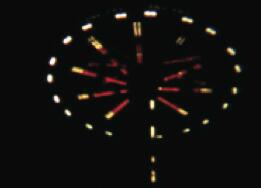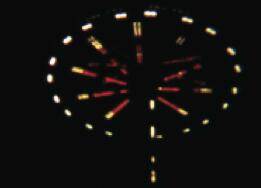Feijão Com Arroz/Rice and Beans
Wynwood, Miami
This exhibition of video work curated by Jacopo Crivelli Visconti stood in stark contrast to its surroundings during the week of the overwhelming Art Basel Miami Beach fair. Not only was the work not gregarious, on the contrary, it was soothing, clear, composed of sparse elements and incredibly poetic. All the videos in this impeccable selection were created in the last five years by the most relevant artists in the current Brazilian art world; artists who have been crucial to the creation of a specific Brazilian visual language—simple (as elementary as rice and beans) and efficient.

Basic, essential ideas and concepts, such as circularity and linearity, were found in the imaginative use of temporality in the videos; they were also the formal elements that linked together the different works. For example, Cinthia Marcelle’s Fonte 193 (Fountain 193) (2007) where a circle is drawn on the soil by the tires of a fire engine that shoots water to the center of the ring; Thiago Rocha Pitta’s Zénite Invertido (Inverted Zenith) (2005), presenting a body of water reflecting the sky whirlpooling down into an empty vortex; Felipe Cohen’s Orbita (Orbit) (2007), showing an orbit of dust and dirt; and Leonora de Barros’s Já vi tudo (I have seen it all) (2005), a video of the circular unraveling of one strand of yarn from a woven mask that covers the artist’s face, all explore the different layers of formal representation of the ideas of circle and line. They were linked by their metaphors and meanings, and different percep- tions of the circle, circular movement, and cyclical temporalities. Linearity was present in all the works, but most markedly in the unraveling of the yarn, where it was in direct dialogue with the nearby video by Regina Parra, Travessia (ou sobre La Marcha) (Journey [or Regarding the March]) (2009), where images of people constantly marching across countries and liminal regions brought attention to the wide and vast territory that a border—seemingly just a line—paradoxically inhabits. And Parra’s dealings with the idea of a march as a permanent transition circulated back to Marcelle’s drawing of infinity by heavyweight machinery. In this Miami venue, the brilliant layout of the exhibition allowed these videos to be viewed simul- taneously, so as to make these and many more connections. All the works also had a hypnotic quality, particularly Hypnosis (2001), by Cão Gimarães, who presented the lights of a theme park fading in and out. The works surrounding Gimarães’s included Marilá Dardot’s Constelações (Constellations) (2003–04), which created a parallel between the constellations in the sky and a nocturnal city skyline, where fading lights gave way to words such as “sea,” “here,” and “day” in Portuguese, and the video RGB_01 (2009), by Albano Afonso, where the play between the three primary colors red, blue, and yellow, with all their range of possi- bilities, came together to create simply a pure and perfect “white.”
The selection also included videos by Rivane Neuenschwander, Brigida Baltar, Camila Sposati, Eder Santos, João Modé, Marcellvs L., Marepe, Niura Bellavinha, Silvia Mecozzi, and Thiago Rocha Pitta. This exhibition offered a successful compilation of refresh- ingly vibrant and pulsating work, which, in our everyday life of visual overload, ultimately rendered visible the invisible.


![Thiago Rocha Pitta. Zénite Invertido [Inverted Zenith] (2005), 10’. Courtesy Galeria Millan / A Gentil Carioca. Thiago Rocha Pitta. Zénite Invertido [Inverted Zenith] (2005), 10’. Courtesy Galeria Millan / A Gentil Carioca.](/var/artealdia_com/storage/images/international/contenidos/resenas/feija_o_com_arroz_rice_and_beans/thiago_rocha_pitta/458225-1-esl-AR/Thiago_Rocha_Pitta_full.jpg)



